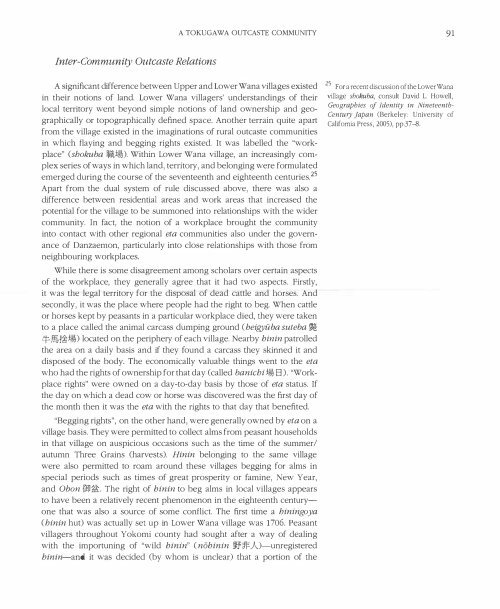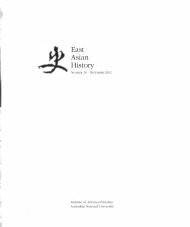Portrait of a Tokugawa Outcaste Community ... - East Asian History
Portrait of a Tokugawa Outcaste Community ... - East Asian History
Portrait of a Tokugawa Outcaste Community ... - East Asian History
Create successful ePaper yourself
Turn your PDF publications into a flip-book with our unique Google optimized e-Paper software.
A TOKUGAWA OUTCASTE COMMUNITY91Inter-<strong>Community</strong> <strong>Outcaste</strong> RelationsA significant difference between Upper and Lower Wana villages existedin their notions <strong>of</strong> land. Lower Wana villagers' understandings <strong>of</strong> theirlocal territory went beyond simple notions <strong>of</strong> land ownership and geographicallyor topographically defined space. Another terrain quite apartfrom the village existed in the imaginations <strong>of</strong> rural outcaste communitiesin which flaying and begging rights existed. It was labelled the "workplace"(shokuba !fij\;t). Within Lower Wana village, an increasingly complexseries <strong>of</strong> ways in which land, territory, and belonging were formulatedemerged during the course <strong>of</strong> the seventeenth and eighteenth centuries. 25Apart from the dual system <strong>of</strong> rule discussed above, there was also adifference between residential areas and work areas that increased thepotential for the village to be summoned into relationships with the widercommunity. In fact, the notion <strong>of</strong> a workplace brought the communityinto contact with other regional eta communities also under the governance<strong>of</strong> Danzaemon, particularly into close relationships with those fromneighbouring workplaces.25 For a recent discussion <strong>of</strong> the Lower Wanavillage shokuba, consult David L. Howell,Geographies <strong>of</strong> Identity in NineteenthCentury Japan (Berkeley: University <strong>of</strong>California Press, 2005), pp.37--B.While there is some disagreement among scholars over certain aspects<strong>of</strong> the workplace, they generally agree that it had two aspects. Firstly,it was the legal territory for the disposal <strong>of</strong> dead cattle and horses. Andsecondly, it was the place where people had the right to beg. When cattleor horses kept by peasants in a particular workplace died, they were takento a place called the animal carcass dumping ground (heigyUba suteba 4-gf@;t) located on the periphery <strong>of</strong> each village. Nearby hinin patrolledthe area on a daily basis and if they found a carcass they skinned it anddisposed <strong>of</strong> the body. The economically valuable things went to the etawho had the rights <strong>of</strong> ownership for that day (called banichi t B). "Workplacerights" were owned on a day-to-day basis by those <strong>of</strong> eta status. Ifthe day on which a dead cow or horse was discovered was the first day <strong>of</strong>the month then it was the eta with the rights to that day that benefited."Begging rights", on the other hand, were generally owned by eta on avillage basis. They were permitted to collect alms from peasant householdsin that village on auspicious occasions such as the time <strong>of</strong> the summer/autumn Three Grains (harvests). Hinin belonging to the same villagewere also permitted to roam around these villages begging for alms inspecial periods such as times <strong>of</strong> great prosperity or famine, New Year,and Obon UEIJ. The right <strong>of</strong> hinin to beg alms in local villages appearsto have been a relatively recent phenomenon in the eighteenth centuryonethat was also a source <strong>of</strong> some conflict. The first time a hiningoya(hinin hut) was actually set up in Lower Wana village was 1706. Peasantvillagers throughout Yokomi county had sought after a way <strong>of</strong> dealingwith the importuning <strong>of</strong> "wild hinin" (nohinin l!!H A)-unregisteredhinin-and it was decided (by whom is unclear) that a portion <strong>of</strong> the
















